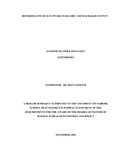| dc.contributor.author | Kinyanjui, Janefer N | |
| dc.date.accessioned | 2016-12-22T13:21:17Z | |
| dc.date.available | 2016-12-22T13:21:17Z | |
| dc.date.issued | 2016 | |
| dc.identifier.uri | http://hdl.handle.net/11295/98345 | |
| dc.description.abstract | Intrauterine Device (IUD) is a long term reversible family planning method which is highly effective but is underutilized both globally and locally. In Kenya, the trends in IUD use show a decline from previous years. The objective of the study was to determine IUD uptake among women seeking FP services in Kiambu and Machakos Hospitals. The study was grounded on theory of demand. The study adopted descriptive and econometrics analysis to determine the uptake of IUD among women seeking family planning services in Kiambu and Machakos Hospitals. Purposive sampling was used to select the study hospitals. Systematic sampling was used to select respondents. Sample size of 380 respondents calculated using Fishers’ formula. The study established that occupation, education, age, place of residence and marital status of women sampled had a significant effect on the uptake of IUD. Based on the results, the study recommends an increase in awareness creation on the availability and benefits of IUD to remove misconceptions. In addition, the study recommends more partner involvement in family planning and girl child education. | en_US |
| dc.language.iso | en | en_US |
| dc.publisher | University of Nairobi | en_US |
| dc.rights | Attribution-NonCommercial-NoDerivs 3.0 United States | * |
| dc.rights.uri | http://creativecommons.org/licenses/by-nc-nd/3.0/us/ | * |
| dc.subject | Determinants of Iud Uptake | en_US |
| dc.title | Determinants of Iud Uptake in Kiambu and Machakos County | en_US |
| dc.type | Thesis | en_US |



